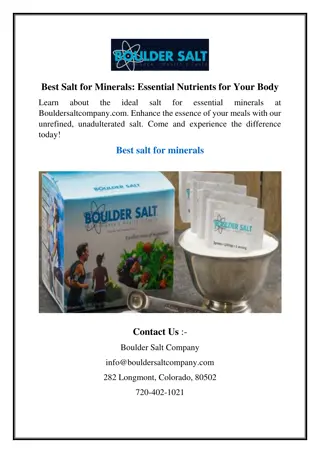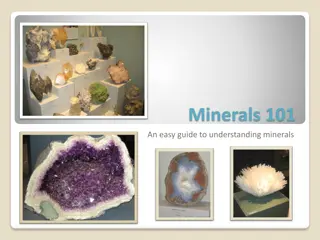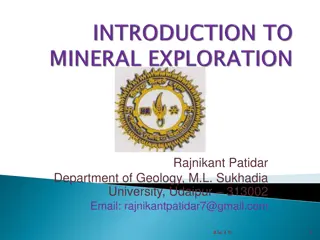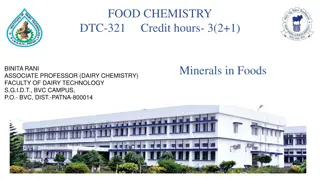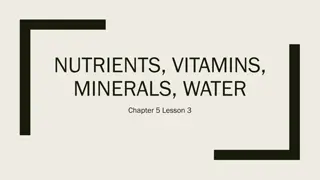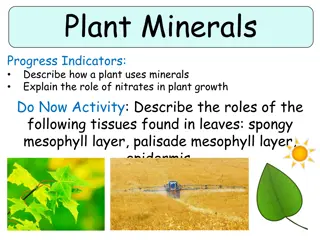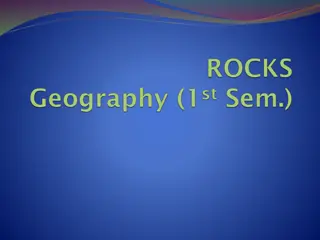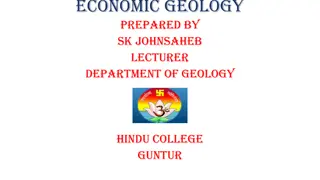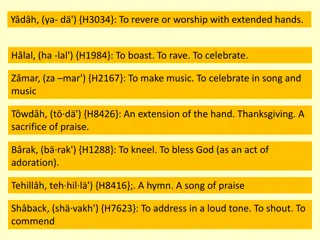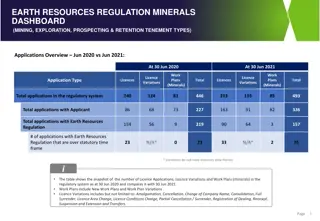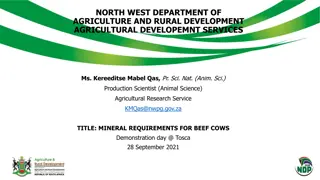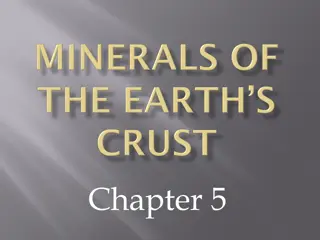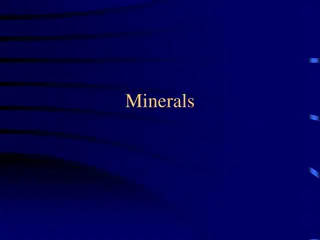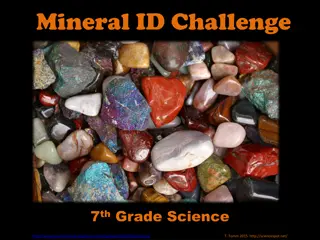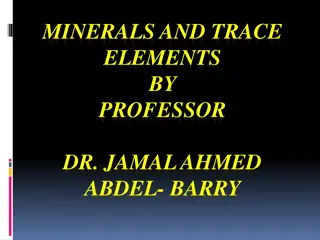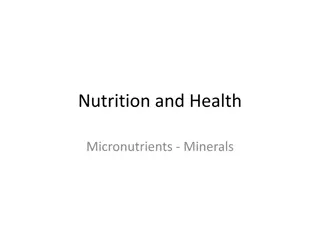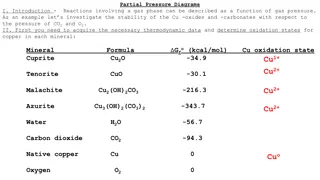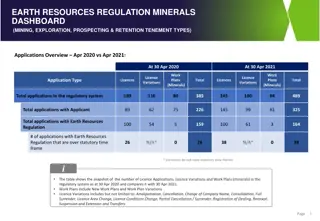Understanding Minerals in Technology: A Hands-on Learning Experience
Delve into the world of sustainable minerals used in technology through an engaging lesson plan. Explore the minerals and metals vital for crafting computers and discover their properties and functions. Engage students in activities to identify minerals in computer components, highlighting the significance of these elements in modern technology.
Download Presentation

Please find below an Image/Link to download the presentation.
The content on the website is provided AS IS for your information and personal use only. It may not be sold, licensed, or shared on other websites without obtaining consent from the author. Download presentation by click this link. If you encounter any issues during the download, it is possible that the publisher has removed the file from their server.
E N D
Presentation Transcript
Sustainable Minerals for Technology NATURE SUNDAY ACADEMY ALL SITE ACTIVITY 2013-2014
SA Schedule 11:00 11:15 am 11:15 11:30 am Introduction Video Ground Rules Film 12:00 12:30 am LUNCH 12:30 1:00 pm Activity 1 Part 1, Minerals used in Computers 1:00 -1:30 pm Activity 1 Part 2 1:30-2:30 pm Activity 2 Ore Body Mystery 2:30-3:30 pm Activity 3 Mineral Identification 3:30-3:45 pm Session Wrap-up Cultural Connection
Objectives of the Lesson Plan Students will explore the rocks, minerals and metals that are used to make various components of a technology gadgets such as IPhones & computers. They will explore the reasons why these materials are useful to computers and they will research the complete lifecycle & characteristics of some of the minerals.
Introduction Ground Rules Film Introduction (Length: 15 minutes) Watch Chapter 3 Mining and the Modern World of the Ground Rules film. 1. What is the importance of minerals in our daily lives? 2. How many minerals are used in a computer (mentioned on the film)?. 3. Name any minerals used in a computer and why they think those minerals were useful for the purposes of building a computer? Discuss the fact that minerals have specific properties that make them useful for certain functions. If we want to build something, we must carefully choose the specific minerals that will provide the functions required.
Activity I (Length: 30 minutes) Part 1: The objective of this activity is to determine the minerals and metals that are used to make a computer and to determine the properties of these elements that are useful for computers. 1. Divide the class into groups of 3 to 4 students. 2. Using resource books or the internet, have each group identify the minerals and metals used to build the following components of a computer: a. Computer monitor b. Computer chip c. Computer circuitry d. Computer case e. Electrical cords
Answer Page Computer Monitor: - Silicon, lead, strontium, phosphorus, boron, indium, barium Computer Chip: - Silicon, gallium Computer Case: - Calcium carbonate, clays, mica, talc, sulfur Computer Circuitry: - Gold, aluminum, lithium, chromium, silver, nickel, gallium, lead, zinc, copper, steel, tungsten, titanium, cobalt, germanium, tin, tantalum Electrical cords: - Copper
Part 2 - Activity I (Length: 30 minutes for Researching/Writing + 10 minutes for discussion) The objective of this activity is to describe the lifecycle of one mineral used in a computer. Students will determine how and where the mineral is mined, how it is processed, how it is built into the component part required in a computer, and how it can be recycled after use. 1. Using the list generated in Part 1 - Activity I, ask each group to select one mineral for further research. 2. Using resource books or the internet, have students conduct research to identify how and where the mineral is mined, how it is processed, how it is made into the component part required in a computer, and how it can be recycled after use. 3. Each group should write a short report on their findings and present it to the class. Discussion (Length: 10 minutes) Pose a question and discuss the following? Review the answers and make a comprehensive class list of the minerals and their useful properties. Based on that list, ask the class to hypothesize what minerals would be useful for another electronic item, such as a television, portable media player, cell phone, etc.
Ore Body Mystery Exploration Questions 1. What are the stages involved in the development of a metal mine? 2. How do geologists determine where mining should occur? 3. What is an Ore body?
Cost and Benefits - Mining In mining, there are a variety of costs, such as exploration work, regulatory processes, equipment, engineering challenges, mining labor, training, health and safety, and reclamation. The benefits of mining arise from the value of the metals extracted. The grade or concentration of the metal as well as its form of occurrence will affect the costs associated with mining the ore. Therefore, it is important to gain an accurate understanding of the geological properties of an ore body. Coal production - mining
What is Drilling? Drilling is an important step in the exploration phase of mining. It collects core samples. During geological exploration at a potential mine site, a drilling rig would be used to drill into the rock and extract cores of rock. These core samples would be analyzed for mineral content, chemistry and various other geological variables. Drilling for Copper mining All of this information would assist the mining company in determining if the ore body is rich enough to support a profitable mine.
Activity 2 - Play Dough Recipe Combine 1 cup flour, cup salt, and 2 tablespoons cream of tartar with 1 cup water, 2 teaspoons food coloring and 1 tablespoon oil in a saucepan. Cook and stir 3-5 minutes, or until it sticks together in a ball. Knead for a few minutes on a lightly floured surface. Store in an air-tight container.
Activity 3 Mineral Identification You will explore some of the physical properties of minerals and how these properties can be used to identify minerals. Materials Mineral identification key (provided) Mohs hardness scale (provided) Mineral Identification Table (provided) Numbered mineral samples (good quality) Hand lens or magnifying glass Streak plates Copper pennies Steel files or nails Bar magnets Diluted hydrochloric acid/vinegar & eyedropper Glass microscope slides Safety goggles and gloves (if necessary)
Questions & Answers Ask students what a mineral is. Minerals are solid, inorganic substances that occur naturally and have specific structures and chemical compositions. Minerals are present in rocks and can be extracted by mining in order to make all of the things we use in our everyday lives. Ask students if they know how to recognize a specific mineral from another. You can tell the differences between minerals by looking for certain properties. Because each mineral is unique both chemically and structurally, each has its own set of physical, optical and structural properties, which aid in its identification. Chemistry refers to the basic building blocks that the mineral is made of. Optical properties refer to the way a mineral looks and what light does when it shines on it. Physical properties such as hardness and streak can be tested easily. Discuss some of the common physical properties of minerals that can be tested to identify a mineral. These are color, luster, cleavage, streak, hardness, magnetism and effervescence.
Additional Information 1. Explain that these are just some of the properties used to identify minerals. Geologists use many more properties to definitively identify a mineral. Crystalline structure Diaphaneity or amount of transparency Tenacity Odor Taste (typically not recommended for students) Specific gravity
Color and Luster Color is often the first property you notice about a mineral, but it may not be the most diagnostic feature. Often color can be misleading because some minerals have a variety of colors. Therefore, it should be used in conjunction with other characteristics. Luster is a description of the way the surface of a mineral reflects light. The easiest distinction to make is whether a mineral has metallic or non-metallic luster. Metallic minerals will have a luster similar to aluminum foil or jewelry. If the mineral is nonmetallic, its luster can be further described as: Vitreous (like glass) Pearly (like a pearl) Waxy (like wax) Resinous (like resin) Greasy (like an oiled surface) Earthy or dull (no real sheen on the surface) Adamantine (brilliant, sparkling, gemlike)
Cleavage and Hardness Cleavage is the tendency of a crystal to break along flat planar surfaces. Cleavage is related to planes of weak chemical bond strength within the mineral. Cleavage is characterized by the number of cleavage planes and angles that the cleavage planes form. Cleavage is also characterized by how well the mineral cleaves (i.e. perfect, good, fair, or poor). Some minerals do not have cleavage. Instead, they fracture into jagged pieces. Streak is the color of particulate dust left behind when a mineral is scraped across an abrasive surface. Streak color is more reliable than surface color as an indicator. The streak color will be constant, but the surface color may vary. Hardness is a measure of the mineral s resistance to scratching or abrasion. It is measured using the Mohs Hardness Scale. This is a scale that measures the hardness of minerals relative to each other. The scale ranges from 1 to 10, with 1 being the softest and 10 being the hardest. A mineral should be able to scratch any mineral with a lower hardness number and can be scratched by any mineral or material with a higher hardness number. The following simple tools with known hardness values can be used to determine mineral hardness: Fingernail hardness of 2-3 Copper penny hardness of 4-5 Steel file/nail hardness of 5-6 Glass hardness of 5-6
Magnetism and Effervescence Magnetism identifies specific iron rich minerals. Only a few minerals such as magnetite or pyrrhotite are magnetic. Effervescence results when weak acid is applied to some minerals that contain calcium carbonate. Carbon dioxide is released in this reaction and the acid will bubble on the surface of the mineral.
Mineral Identification Table Property Sample Number 3 1 2 4 5 Color Luster Cleavage Streak Hardness Magnetic Effervesce nt Mineral Type



